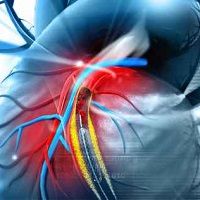Article
Is Psoriatic Arthritis a Risk Factor for Vascular Disease?
Author(s):
New research comparing patients and controls suggests that the body’s inflammatory response to psoriatic arthritis can lead to atherosclerosis and then to cardiovascular disease.

New research comparing patients and controls suggests that the body’s inflammatory response to psoriatic arthritis can lead to atherosclerosis and then to cardiovascular disease.
Â
Investigators examined 18 psoriatic arthritis patients and 18 age-and-sex-matched controls, looking for relationships (in both groups) between carotid intima-media thickness (CIMT) — which is a strong indicator of atherosclerosis — and numerous markers of inflammation and vascular function.
Â
The inflammation markers included C-reactive protein (CRP), erythrocyte sedimentation rate (ESR), and several pro-inflammatory cytokines: interleukin (IL)-1, IL-6, and tumor necrosis factor (TNF)-α. The markers of vascular function included lipids, intercellular adhesion molecule 1 (ICAM-1), vascular cell adhesion molecule 1 (VCAM-1), and endothelial progenitor cells (EPCs).
Â
Compared with controls, psoriatic arthritis patients exhibited significantly higher CIMT (0.062 cm ± a standard deviation of 0.18 cm vs. 0.045 ± 0.10 cm; p < 0.01). They also expressed significantly higher levels of biomarkers related to inflammation: ESR, CRP, TNF-α, IL-6, ICAM-1, and VCAM-1.
Â
Biomarkers related to good vascular function, on the other hand, were reduced in psoriatic arthritis patients. They had significantly lower flow mediated dilation (FMD) and endothelial progenitor cells (EPCs), as well as significantly less high-density lipoprotein (HDL) cholesterol (p < 0.05).
Â
In psoriatic arthritis patients, CIMT positively correlated with IL-6 and ICAM-1 and inversely correlated with FMD, HDL, and EPCs (p < 0.05). What’s more, FMD and CIMT were both impaired in the psoriatic arthritis cohort, indicating endothelial dysfunction and accelerated atherosclerosis.
Â
Â
“Although CIMT and FMD — as well as some laboratory factors — have previously been assessed by other investigators in psoriatic arthritis-associated atherosclerosis, our results regarding the possible involvement of pro-inflammatory cytokines, adhesion molecules, and EPCs level are novel and suggest a possible mechanism of atherosclerosis in psoriatic arthritis,†the study authors wrote in the International Journal of Angiology.
Â
Prior studies have found elevated rates of both atherosclerosis and cardiovascular disease in patients with psoriatic arthritis. Unfortunately, the authors of the new study wrote, the patients in those studies had too many comorbidities to determine whether their increased risk of cardiovascular disease stemmed from their psoriatic arthritis or from their hypertension, diabetes and other medical problems.
Â
The new study specifically excluded psoriatic arthritis patients with diabetes mellitus (glycated hemoglobin A1c ≥ 6.5), hypertension (systolic blood pressure > 140 mm Hg or diastolic blood pressure > 90 mm Hg), a history of cardiovascular or cerebrovascular disease, renal failure (serum creatinine values > 1.3 mg/dL), thyroid dysfunction, multiple sclerosis, human immunodeficiency virus, and rheumatic diseases other than psoriatic arthritis. Smokers and heavy drinkers were likewise excluded.
Â
The fact that the psoriatic arthritis patients in the study still exhibited elevated CIMT — even in the absence of those other risk factors for cardiovascular disease — indicates that psoriatic arthritis is an independent risk factor for cardiovascular disease, wrote the study authors. What’s more, they continued, the positive correlation between CIMT and inflammatory markers in psoriatic arthritis patients suggests that systemic inflammation explains the elevated risk, at least to some degree.
Â
Oddly, the apparent severity of each patient’s psoriatic arthritis — as measured by disease activity score of 28 joints count (DAS28) and disease activity in psoriatic arthritis (DAPSA) — bore no significant relation to markers of inflammation or CIMT. Inflammation levels and CIMT did vary from patient to patient, but the most debilitated patients did not exhibit significantly more atherosclerosis risk than the least debilitated patients.
Â
Â


